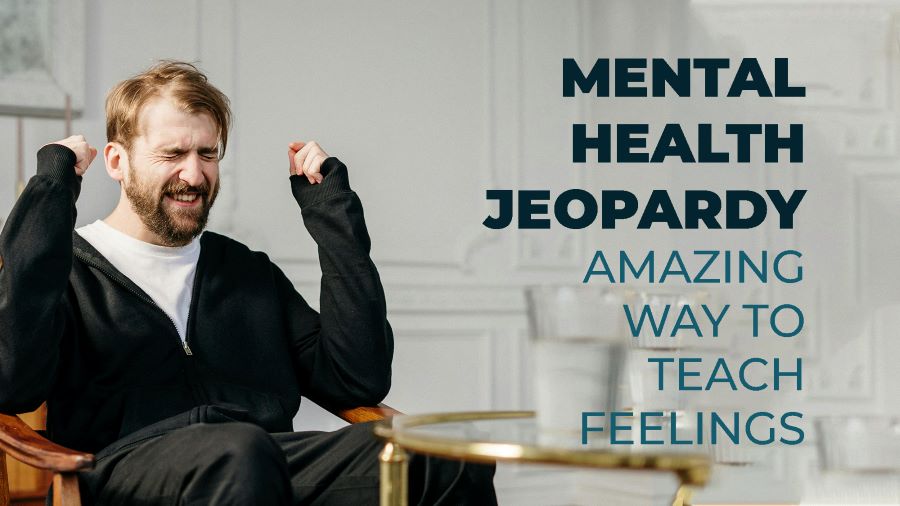What Is Mental Health Jeopardy and Why Is It So Engaging?
Imagine the classic Jeopardy! game show, but instead of “World Capitals” or “Shakespeare Quotes,” you’ve got categories like “Stress Busters,” “Feelings and Emotions,” and “Self-Care Strategies.”

This game works well because it breaks things into small chunks — questions, answers, and discussion. It’s simple. Kids especially love the challenge of picking a category and testing what they know. And when they get it wrong? It’s a teaching moment, not a lecture.
For teens, it brings a sigh of relief. They don’t want to be stared at while discussing something personal. A group game creates a sense of safety. One teen in a middle school session even said, “I didn’t feel weird saying I get anxious — everyone laughed when I buzzed in too fast.” That shared laughter helps reduce the fear of judgment.
Even adults can benefit. Group therapy sessions often use games like this to ease people into tough conversations. It’s like opening a heavy door with a lighter key.
So, is jeopardy good for your brain? Absolutely. It stimulates thinking, memory, and emotional connection — all while being low-pressure.
Using Mental Health Jeopardy For Kids: Building Confidence Early
Young children often don’t have the words to say, “I feel anxious” or “I’m overwhelmed.” But show them a cartoon face that’s sad, silly, or angry, and they’ll point it out in a second. That’s exactly why tools like mental health jeopardy work so well for kids — they speak the language of play.
The categories are playful and often visual, making it easy for little ones to engage. You might see things like:
-
Name That Emotion!
-
Who Can Help?
-
Healthy Habits
Instead of written answers, kids might pick the right picture, act out a feeling, or share a short story—like what they’d do if their friend didn’t want to play.
A preschool teacher in Dhaka once said, “We tried it during circle time. At first, the kids were shy. But by the end, they were telling stories about losing toys and sharing snacks—it turned into a heart-to-heart disguised as a game.”
These playful activities do more than entertain. They help children build emotional vocabulary, practice social skills, and understand that feelings are okay to talk about. And because it’s so gentle, this game-style approach fits perfectly in classrooms, therapy sessions, or even quiet moments at home.
Mental Health Jeopardy For Teens: Breaking Through The Silence
Teenagers live in a whirlwind of emotions. School pressure, body changes, social drama — it’s a lot. And sometimes, they clam up. That’s why mental health jeopardy for teens works so well. It meets them where they are.
Instead of forcing a heart-to-heart, the game makes space for group discussion, laughter, and learning. It’s not therapy, but it opens the door.
Popular categories for teens include:
- “Stress and Anxiety”
- “Friendship Fixers”
- “Myth or Fact?”
A high school in Chittagong ran a game where one question was: “True or False: You can just snap out of depression.” The group buzzed in quickly. Some said yes, some no. The discussion that followed was rich and personal.
This kind of back-and-forth builds understanding. It helps teens realize they’re not alone. And it introduces healthy coping without being preachy.
Guidance counselors often use these games before mental health units or wellness weeks. It’s a way to break the ice and see what kids already know — and where the gaps are.
Making Your Own Mental Health Jeopardy Game: It’s Easier Than You Think
You don’t need fancy tools or an official board to create your own mental health jeopardy. A marker, a whiteboard, or a PowerPoint will do.

Here’s how to build one in minutes:
- Pick 4–5 categories. Think “Coping Tools,” “Feelings 101,” or “Healthy vs Unhealthy.”
- Create 5 questions per category. Start easy and get harder with each row.
- Make sure answers are brief and clear. You’re starting a conversation, not giving a test.
- Keep it light but meaningful. Add humor when appropriate.
Want examples? Here are some questions:
- “What’s one thing you can do if you’re feeling sad at school?”
- “Name two healthy ways to calm down when angry.”
- “True or False: You should keep your feelings bottled up.”
Games can be played in classrooms, family nights, or peer groups. Add prizes if you like — stickers, snack coupons, or a goofy crown for the winner.
You can also download templates online or use Google Slides. Some websites offer free versions tailored to different age groups.
It’s not about perfection. It’s about getting people to talk.
Mental Health Jeopardy in Classrooms and Exams: A Different Approach to Learning
Many educators are adding mental health jeopardy to their lesson plans, especially in health or social science classes. It’s interactive and helps reinforce concepts covered in mental health exam examples.
For instance, instead of handing out a worksheet on stress symptoms, a teacher might ask:
- “What are three physical signs of stress?”
- “Which part of the brain helps control emotions?”
- “True or False: Mental illness is rare in teens.”
These questions mirror test formats but are more engaging. And for students who fear tests, this method lowers anxiety while improving recall.
In a Rangpur school, teachers noticed students scored higher on mental health assessments after using jeopardy games. Why? Because they were learning through conversation, not cramming.
It’s also great for reviewing key ideas before quizzes. The game format offers instant feedback, group participation, and memory cues.
Teachers across Bangladesh and beyond are seeing results — better understanding, better test scores, and more confident kids.
Turning Conversations into Connection
Talking about feelings can be tough—especially with kids and teens who might not yet have the vocabulary to express what’s going on inside. That’s where playful tools come in, transforming emotional education into something less intimidating and more inviting. When you introduce a game format, it takes the pressure off and turns serious topics into approachable moments. Players aren’t just answering questions—they’re learning how to name emotions, recognize healthy habits, and discover who they can turn to for support. This approach doesn’t just teach mental wellness; it fosters connection, empathy, and confidence in a way that sticks.

My First Time Using Mental Health Jeopardy
I’ll never forget the first time I tried using this game-style tool during a group session with preteens. I was nervous, to be honest. I wasn’t sure how they’d react—would they laugh it off or just sit in silence? But the moment I introduced the categories—like “Name That Emotion” and “What Would You Do?”—their faces lit up with curiosity.
One boy, usually quiet and withdrawn, surprised everyone. When asked to describe what anger felt like, he acted out a clenched fist and said, “It’s like when my chest feels hot, and I just want to yell.” That was a breakthrough—not just for him, but for the group. Others nodded and added their own stories, and suddenly, the room felt lighter. Safe. Honest.
That one session taught me more than any training manual ever could: when we make learning about emotions interactive and judgement-free, kids open up in beautiful, unexpected ways. What started as a game ended as a meaningful conversation none of us saw coming.
FAQ’s
-
What is this game used for?
It’s a fun and educational way to help people—especially children and teenagers—learn about emotions, mental wellness, and healthy coping strategies. -
Can it be used in therapy sessions?
Absolutely. Many therapists and counselors use it as a light-hearted icebreaker or group activity to help clients feel more at ease opening up. -
Is this type of game good for your brain?
Yes! It boosts memory, focus, and emotional awareness by blending play with meaningful content. -
How can I create my own version?
Pick a few categories and write age-appropriate questions. You can build it using flashcards, slides, or even free online game platforms. -
Are there different versions for younger and older players?
Yes, the questions and topics are typically adapted to match different ages, maturity levels, and vocabulary skills.
Conclusion: A Playful Step Toward Serious Conversations
Talking about mental health doesn’t have to be stiff or scary. Mental health jeopardy is proof that learning about our feelings can actually be fun. Whether it’s a kindergartener naming emotions or a teen busting myths about anxiety, the game opens minds and hearts.
And in a world where people often struggle to say how they feel, that’s a big win.

